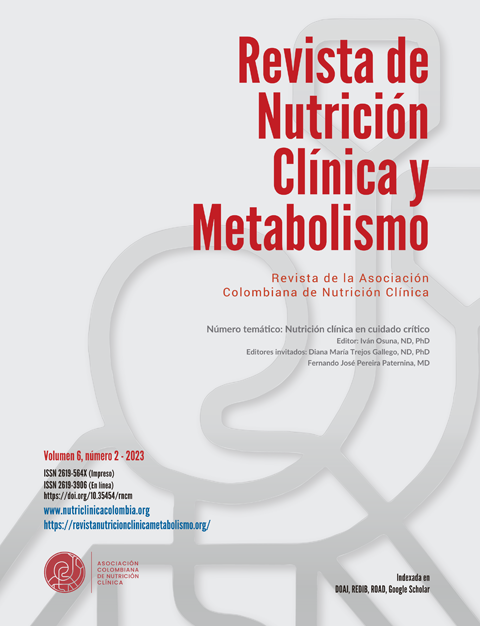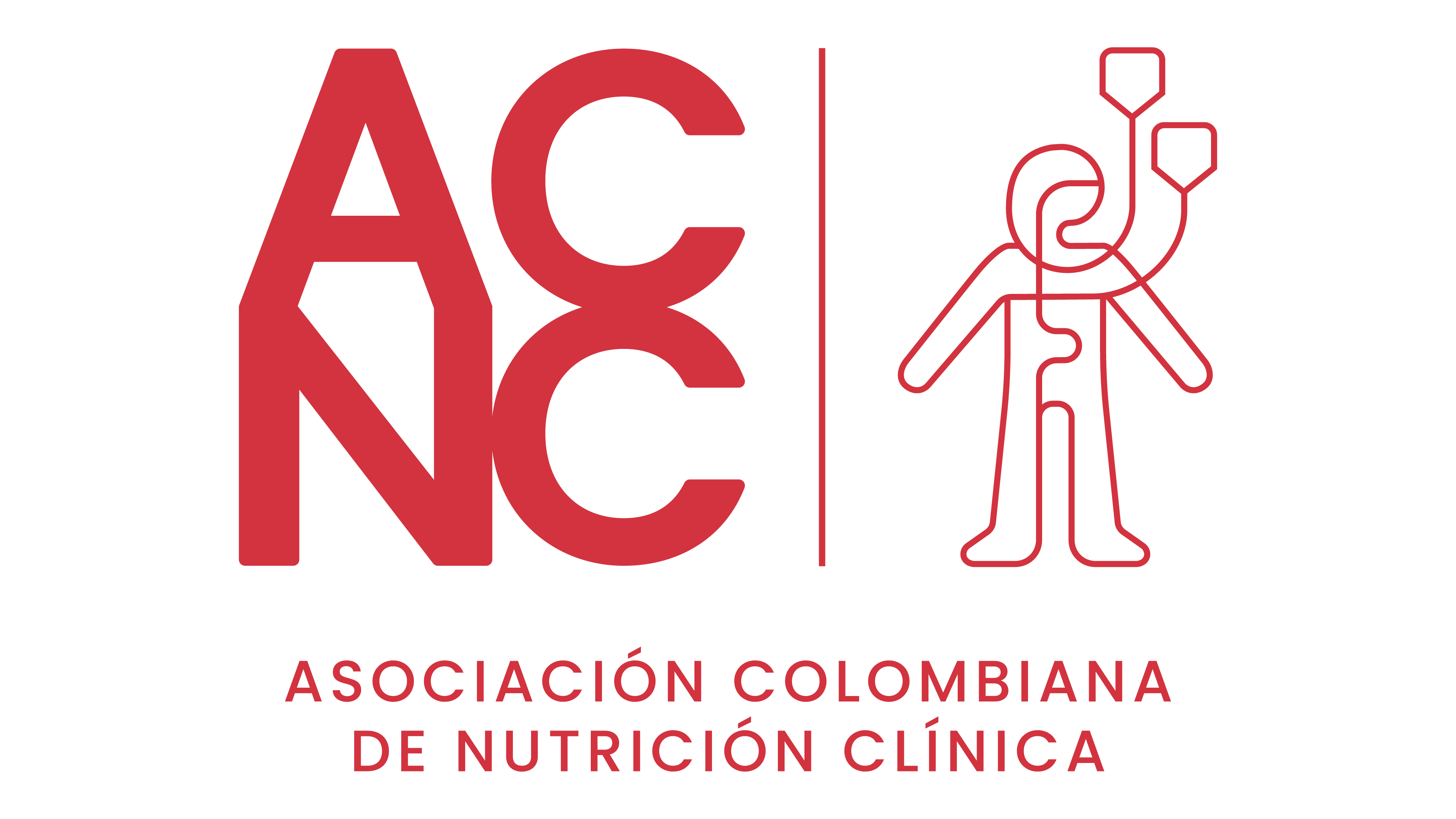Análisis de sobrevida en pacientes críticos con soporte nutricional según el puntaje mNUTRIC
DOI:
https://doi.org/10.35454/rncm.v6n2.483Palabras clave:
mNUTRIC Score, Supervivencia, Tiempo de Estadía, Cuidados Críticos, Nutrición EnteralResumen
Introducción: la herramienta mNUTRIC fue diseñada para identificar a los pacientes internados en las unidades de cuidados intensivos (UCI) con una intervención nutricional optimizada e intensiva. Según diversas guías de práctica clínica, el riesgo nutricional se relaciona con la mortalidad y estancia hospitalaria.
Objetivos: analizar la asociación entre la sobrevida a los 30 días y la estancia en las UCI con el puntaje de mNUTRIC, ajustado por el aporte calórico-proteico.
Métodos: se incluyeron 110 pacientes internados en tres salas de UCI de un hospital público de Buenos Aires. A través de un diseño observacional, longitudinal, analítico y ambispectivo, se realizó un análisis de sobrevida y modelos de regresión Cox.
Resultados: según los modelos múltiples, el riesgo de muerte aumentó en promedio un 4 % por cada año que aumentaba la edad (p = 0,002) y se redujo en promedio un 79 % por cada gramo adicional de proteína por kilo de peso corporal aportada (p = 0,021). La probabilidad de egreso de la UCI se redujo a mayor edad (p = 0,002). El mNUTRIC, sexo, aporte calórico, la obesidad y la infección por enfermedad por coronavirus de 2019 (COVID-19) no se asociaron a las variables de resultado.
Conclusiones: el mNUTRIC no se asoció a la mortalidad y a la estancia en la UCI, la infección por COVID-19 pudo haber atenuado su impacto. El aporte proteico fue un factor protector para la mortalidad, por lo que se deben implementar estrategias adicionales para optimizarlo.
Descargas
Citas
Compher C, Bingham AL, McCall M, Patel J, Rice TW, Braunschweig C, et al. Guidelines for the provision of nutrition support therapy in the adult critically ill patient: The American Society for Parenteral and Enteral Nutrition. J Parenter Enteral Nutr. 2022;46(1):12-41. doi: 10.1002/jpen.2267
Singer P, Blaser AR, Berger MM, Alhazzani W, Calder PC, Casaer MP, et al. ESPEN guideline on clinical nutrition in the intensive care unit. Clinical Nutrition. 2019;38(1):48-79. doi: 10.1016/j.clnu.2018.08.037
Castillo Pineda JC, Gómez García A, Velasco N, Díaz-Pizarro Graf JI, Matos Adámes A, Miján de la Torre A. Nutritional assessment of hospitalized patients in Latin America: association with prognostic variables: The ENHOLA study. Nutrición Hospitalaria. 2016;33(3):655-62. doi: 10.20960/nh.275
Paez Candelaria Y, Romero García LI, Pereira Despaigne COL, Gondres Legró KM, Bacardí Zapata PA, Legró Bisset G. Factores predictivos de desnutrición en pacientes graves. Acta Colombiana de Cuidado Intensivo. 2018;18(1):10-21. doi: 10.1016/j.acci.2017.11.004
Reintam Blaser A, Starkopf J, Alhazzani W, Berger MM, Casaer MP, Deane AM, et al. Early enteral nutrition in critically ill patients: ESICM clinical practice guidelines. Intensive Care Med. 2017;43(3):380-98. doi: 10.1007/s00134-016-4665-0
Correia MITD, Perman MI, Waitzberg DL. Hospital malnutrition in Latin America: A systematic review. Clin Nutr. 2017;36(4):958-67. doi: 10.1016/j.clnu.2016.06.025
Barritta RL, Villar Á, Bordalejo A, Nadal MA. Nutrición enteral en el paciente crítico: ¿cuánto es realmente administrado?. Rev Arg de Ter Int. 2019;36(2):p11-18. Disponible en: https://revista.sati.org.ar/index.php/MI/article/view/564
Stewart ML. Interruptions in enteral nutrition delivery in critically ill patients and recommendations for clinical practice. Crit Care Nurse. 2014;34(4):14-21. doi: 10.4037/ccn2014243
Heyland DK, Dhaliwal R, Wang M, Day AG. The prevalence of iatrogenic underfeeding in the nutritionally ‘at-risk’ critically ill patient: Results of an international, multicenter, prospective study. Clinical Nutrition. 2015;34(4):659-66. doi: 10.1016/j.clnu.2014.07.008
Heyland DK, Dhaliwal R, Jiang X, Day AG. Identifying critically ill patients who benefit the most from nutrition therapy: the development and initial validation of a novel risk assessment tool. Crit Care. 2011;15(6):R268. doi: 10.1186/cc10546
De Vries MC, Koekkoek W, Opdam MH, van Blokland D, van Zanten AR. Nutritional assessment of critically ill patients: validation of the modified NUTRIC score. Eur J Clin Nutr. 2018;72(3):428-35. doi: 10.1038/s41430-017-0008-7
Reis AM dos, Fructhenicht AVG, Moreira LF. NUTRIC score use around the world: a systematic review. Rev Bras Ter Intensiva. 2019;31(3):379-385. doi: 10.5935/0103-507X.20190061
Kalaiselvan MS, Renuka MK, Arunkumar AS. Use of nutrition risk in critically ill (NUTRIC) score to assess nutritional risk in mechanically ventilated patients: A prospective observational study. Indian J Crit Care Med. 2017;21(5):253-256. doi: 10.4103/ijccm.IJCCM_24_17
Mendes R, Policarpo S, Fortuna P, Alves M, Virella D, Heyland D. Nutritional risk assessment and cultural validation of the modified NUTRIC score in critically ill patients—A multicenter prospective cohort study. J Crit Care. 2017;37:45-49. doi: 10.1016/j.jcrc.2016.08.001
Bernasconi Jose I, Leandro-Merhi VA, Mendonça JA, Braga de Aquino JL. The diagnosis and NUTRIC score of critically ill patients in enteral nutrition are risk factors for the survival time in an intensive care unit? Nutr Hosp. 2019;36(5):1027-36. doi: 10.20960/nh.02545
Riley RD, Ensor J, Snell KIE, Harrell FE, Martin GP, Reitsma JB, et al. Calculating the sample size required for developing a clinical prediction model. BMJ. 2020;368:m441. doi: 10.1136/bmj.m441
Rahman A, Hasan RM, Agarwala R, Martin C, Day AG, Heyland DK. Identifying critically-ill patients who will benefit most from nutritional therapy: Further validation of the “modified NUTRIC” nutritional risk assessment tool. Clin Nutr. 2016;35(1):158-62. doi: 10.1016/j.clnu.2015.01.015
McClave SA, Taylor BE, Martindale RG, Warren MM, Johnson DR, Braunschweig C, et al. Guidelines for the Provision and Assessment of Nutrition Support Therapy in the Adult Critically Ill Patient: Society of Critical Care Medicine (SCCM) and American Society for Parenteral and Enteral Nutrition (A.S.P.E.N.). JPEN J Parenter Enteral Nutr. 2016;40(2):159-211. doi: 10.1177/0148607115621863
Bousie E, Van Blokland D, Lammers HJW, Van Zanten ARH. Relevance of non-nutritional calories in mechanically ventilated critically ill patients. Eur J Clin Nutr. 2016;70(12):1443-50. doi: 10.1038/ejcn.2016.167
Kleinbaum DG, Klein M. Survival analysis: a self-learning text. 3rd edition. New York: Springer; 2012.
Wu S, Lou J, Xu P, Luo R, Li L. Early enteral nutrition improves the outcome of critically ill patients with COVID-19: A retrospective study. Asia Pac J Clin Nutr. 2019;30(2):192-8. doi: 10.6133/apjcn.202106_30(2).0002
Muscedere J, Waters B, Varambally A, Bagshaw SM, Boyd JG, Maslove D, et al. The impact of frailty on intensive care unit outcomes: a systematic review and meta-analysis. Intensive Care Med. 2017;43(8):1105-22. doi: 10.1007/s00134-017-4867-0
Brascher JMM, Peres W a. F, Padilha PC. Use of the modified «Nutrition Risk in the critically ill» score and its association with the death of critically ill patients. Clin Nutr ESPEN. 2020;35:162-6. doi: 10.1016/j.clnesp.2019.10.005
Zhang P, He Z, Yu G, Peng D, Feng Y, Ling J, et al. The modified NUTRIC score can be used for nutritional risk assessment as well as prognosis prediction in critically ill COVID-19 patients. Clin Nutr. 2021;40(2):534-41. doi: 10.1016/j.clnu.2020.05.051
Jeong DH, Hong SB, Lim CM, Koh Y, Seo J, Kim Y, et al. Relationship between Nutrition Intake and 28-Day Mortality Using Modified NUTRIC Score in Patients with Sepsis. Nutrients. 2019;11(8):1906. doi: 10.3390/nu11081906
Allingstrup M, Esmailzadeh N, Wilkens Knudsen A, Espersen K, Hartvig Jensen T, Wiis J, et al. Provision of protein and energy in relation to measured requirements in intensive care patients. Clin Nutr. 2012;31(4):462-8. doi: 10.1016/j.clnu.2011.12.006
Chada RR, Chidrawar S, Goud BA, Maska A, Medanki R, Nagalla B. Association Between Nutrition Delivery, Modified Nutrition Risk In Critically III Score, and 28-Day Mortality. Nutr Clin Pract. 2021;36(5):1020-33. doi: 10.1002/ncp.10673
Silvah JH, de Lima CMM, Nicoletti CF, Barbosa AC, Junqueira GP, da Cunha SF de C, et al. Protein provision and lower mortality in critically ill patients with COVID-19. Clin Nutr ESPEN. 2021;45:507-510. doi: 10.1016/j.clnesp.2021.07.005
Mukhopadhyay A, Henry J, Ong V, Leong CSF, Teh AL, Van Dam RM, et al. Association of Modified Nutric Score with 28-Day Mortality in Critically Ill Patients. Clin Nutr. 2017;36(4):1143-8. doi: 10.1016/j.clnu.2016.08.004
Coltman A, Peterson S, Roehl K, Roosevelt H, Sowa D. Use of 3 tools to assess nutrition risk in the intensive care unit. JPEN J Parenter Enteral Nutr. 2015;39(1):28-33. doi: 10.1177/0148607114532135
Wang N, Wang MP, Jiang L, Du B, Zhu B, Xi XM. Association between the modified Nutrition Risk in Critically Ill (mNUTRIC) score and clinical outcomes in the intensive care unit: a secondary analysis of a large prospective observational study. BMC Anesthesiol. 2021 8;21(1):220. doi: 10.1186/s12871-021-01439-x
Liberti A, Piacentino E, Umbrello M, Muttini S. Comparison between Nutric Score and modified nutric score to assess ICU mortality in critically ill patients with COVID-19. Clinical Nutrition ESPEN. 2021;44:479-82. doi: 10.1016/j.clnesp.2021.04.026
Li G, Zhou CL, Ba YM, Wang YM, Song B, Cheng XB, et al. Nutritional risk and therapy for severe and critical COVID-19 patients: A multicenter retrospective observational study. Clin Nutr. 2021;40(4):2154-2161. doi: 10.1016/j.clnu.2020.09.040
Osuna-Padilla IA, Rodríguez-Moguel NC, Aguilar-Vargas A, Rodríguez-Llamazares S. High nutritional risk using NUTRIC-Score is associated with worse outcomes in COVID-19 critically ill patients. Nutr Hosp. 2021;28(3):540-4. doi: 10.20960/nh.03440
Singh R, Rathore SS, Khan H, Karale S, Chawla Y, Iqbal K, et al. Association of Obesity With COVID-19 Severity and Mortality: An Updated Systemic Review, Meta-Analysis, and Meta-Regression. Front Endocrinol (Lausanne). 2022;13:780872. doi: 10.3389/fendo.2022.780872
Paravidino VB, Leite TH, Mediano MFF, Sichieri R, Azevedo E Silva G, Cravo V, et al. Association between obesity and COVID-19 mortality and length of stay in intensive care unit patients in Brazil: a retrospective cohort study. Sci Rep. 2022;12(1):13737. doi: 10.1038/s41598-022-17197-w
Publicado
Cómo citar
Número
Sección
Licencia
Derechos de autor 2023 Ommi Acosta Sero, Micaela Di Iorio, Ailén Azul Perez

Esta obra está bajo una licencia internacional Creative Commons Atribución-NoComercial-CompartirIgual 4.0.




















